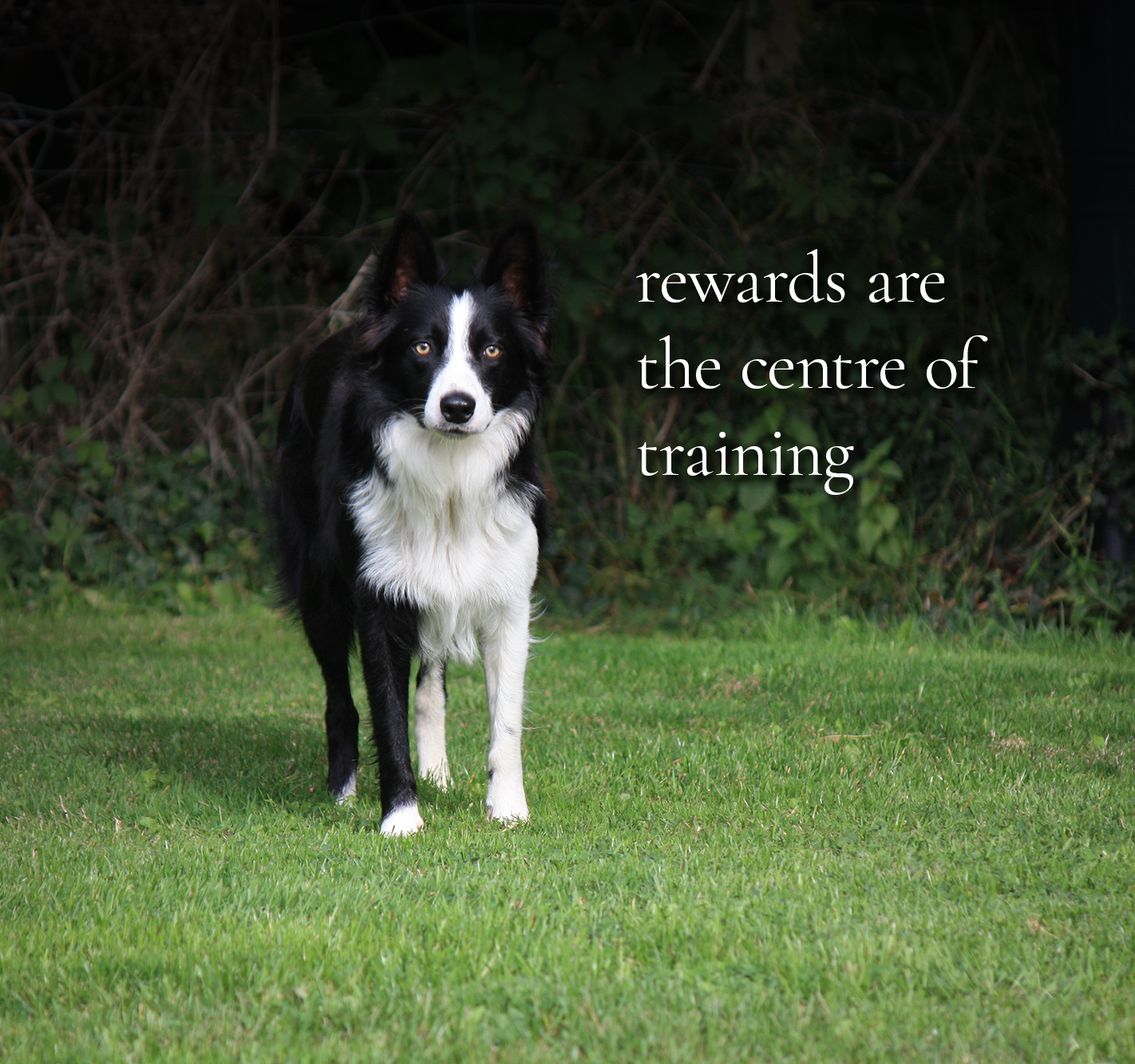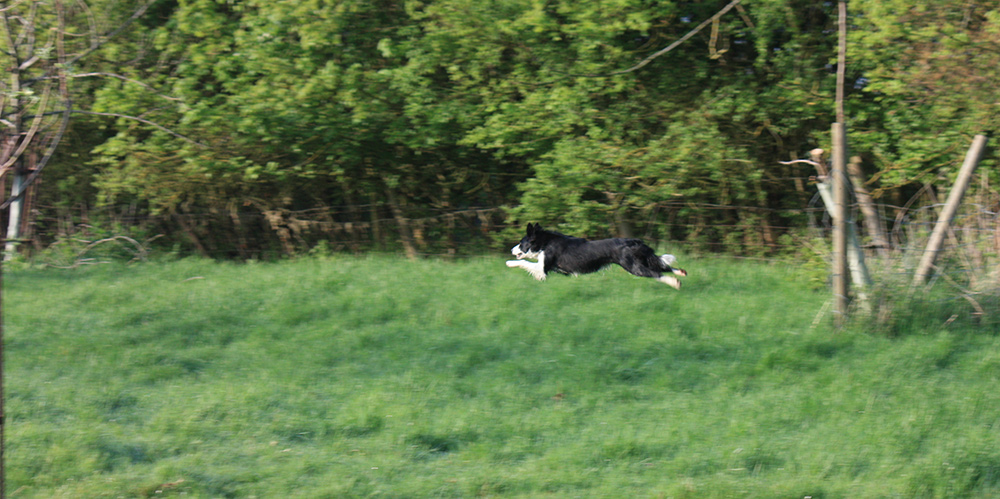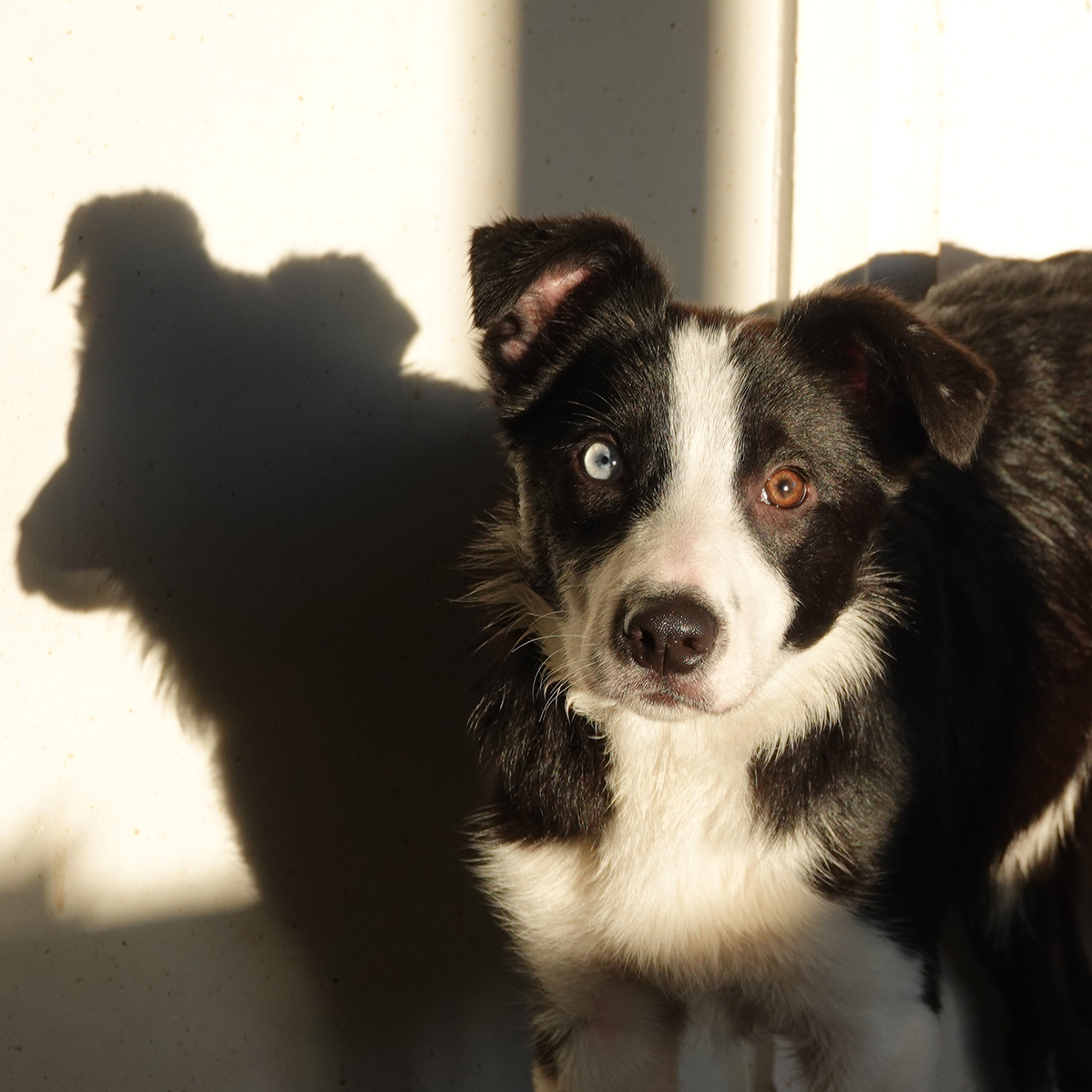Shaping by rewards

When we bring together our knowledge, understanding and skills we begin to make significant learning progress. Exploring old landscapes with new eyes changes what we see, knowledge changes how we process what we see, and doing it gives us experience from which we can make educated choices.
It may seem easier to sit back and follow a step-by-step recipe that has been tried and tested many times and proven successful. The follow-process may suit a beginner, or someone needing a quick tray of muffins but it rarely brings understanding until we build our own recipes.
Having discovered this world of rewards and reinforcement I protectively wrap my dogs’ learning with an envelope of reward probabilities. This is where I begin.
When I see a dog showing a behaviour that is heading towards potential conflict, my first question is “what rewards are available?”
When Zip arrived at 5 months old, her need to protect valuable resources was a potential conflict with my other dogs who politely tolerated her. The precious resources were food and me. In collie-world management of the environment is a necessity and very strong reward. When this was combined with a need to protect a resource conflict was developing nicely in a pool of adolescence. Preparation of meals produced extreme shark like behaviour towards all the dogs, and if she was crated it converted to screaming. I also received very frenzied onslaughts of need for engagement, she would “come at me hot” and throw herself upwards at my face for social approval, with force. Neither of these behaviours could possibly reduce by being “ignored”, nor were treats for calm responses a possibility and I certainly was not going to suppress these symptoms with a “good sit”. The symptoms were my data, the information of progress and how my alteration of rewards was affecting her.
My rewards aligned with her rewards: food and me. Food sources were around the house all the time. Open containers that were safely out of reach filled the house with scent and removed the arousal associated with feeding time: the super-events of potential rewards. Rewards were potential all the time and delivered extremely frequently, to all the dogs. For a couple of weeks meal times were non-events, stomachs filled regularly and the resources shared together as a group. I turned the dogs into grazers. If the resource protection was as a result of hunger this was reduced.
At this point I will give some background information on “barn rearing” pups on a farm. Often the litter is left to their own devices when food is delivered and it is survival of the fittest. As a very small collie I suspect she was the smallest in the litter and needed to fight and protect her portion to gain any food. When hunger is always a potential threat the need to eat when you can, and eat fast never seems to fade.
I used the same protocol of multiple access to me, reducing the super-events of interacting with me to non-events. She was given stations to go to and receive copious amounts of attention and engagement as often as possible through the day. She would have preferred access to me 100% of the time and prevent the other dogs accessing me as well, but that was not practical. At the same time we began some more specific training sessions.

Looking at the triangle of rewards, where we select a reward that is compatible with the behaviour, considered a reward by the dog and comfortable for the person, I employed the reward stations. She had specific locations around the environment – 5 altogether where she was elevated and self-contained – the grooming table, a window sill, a foot stool, staircase and garden table. Any time she needed to “come at me hot” I redirected her to the stations and we indulged in moments of connection. I used the elevated element to remove the jumping at my face, without the jump it is just frenetic licking, it also put the other dogs out of harm’s way. The behaviour was a combination of protecting her resource, me, and gaining approval from me. I introduced reward predicting stimuli to go to the stations, the cue “up up”, which I still use, and reward, several times a day.
For the first few months as I developed other rewarding activities the symptoms were showing a significant reduction. However when these reward stations were not available I would still be in danger of the “hot greeting”. Love has no boundaries!
As we go for our daily outings in familiar fenced fields she was developing an impressive outrun of the boundaries. This showed all the evidence of an activity of high value to her- in that she is a very physical and fit runner who enjoys flying the vegetation. Once she discovered these pleasures were delivered when I opened the gates I was able to add cues (reward predicting stimuli) and use those cues as markers for management behaviours (going to the gate and waiting at the gate).

When out walking in these fields I incorporate fresh opportunities to “run the boundaries”, which look like outruns to the left or right in very large circles. I am the sheep as well as the shepherd. Now when she comes running at me “hot” (“like a freakin’ bullet” as a friend described it) to shower me with a frenzy of love, before she arrives I can cue her to go around behind me and out for another boundary circuit.
The reward of running the boundary circuit, with my approval and engagement is of more value than the in-my-face frenzy. We will continue to run the boundary-games, where I send her out and about, with loops to and fro. If I do get a little distracted and over focussed on bird watching, I get a reminder, but these incidents are week’s apart instead of minutes.
Interesting elements pop out. There is a correlation between uncertainty and the behaviours. When she seems confident and assured she shows the normal, browsing the fields behaviours, gently affectionate when called in. But when surprised by a giant sack blowing through the field we returned to the blazing bullet.
She does love to play with toys, by herself. Playing with me seems to activate the very wrong responses and she becomes wildly out of control.

We regularly have “garden dinner” which is a garden showered with much and variable tasty treats. A highlight for the other dogs to search and explore, and for her she enjoys it with no signs of needing to guard or search in a frenzy or eat fast. She is just a browser.
The other significant events such as dinner preparation are managed with frequent delivery of prepared treats during the process. She is intensely focused all the time, occasional reminders to the other dogs that Her Place is the position nearest me during this activity but no sharks, and I still have all my fingers.
She does not beg for food, she can sleep away from me, and two years further down the road is very much the active learner participating in any activity I am entertained with.
This is not a recipe for solutions. This is a process whereby a careful examination of the rewards for this individual, that can be safely employed to re-balance her needs so that the symptom-conflict behaviours are greatly reduced.
She is not fixed.
If her need to control the environment is restricted, or she becomes stressed by unpredictable events, or goes hungry I have no doubt resurgence will occur.
“Rewards are the centre of life”.
Her rewards are her rewards and it is an example of how I need to understand those rewards and shift them to reward compatible behaviour that we can live together with, not just survive.
It is an example of shaping by rewards not suppression by rewards.
Explore
COURSES

Build the Learning
Lifelong skills built in activities and play. A dog that is curious, confident, resilient with a natural enthusiasm for learning.
rewards skills
Learn about the fascinating landscape of rewards and how to make them the centre of your training and relationship.
Management or Training
Find a pathway to suit your lifestyle of living with dogs. When management temporarilly supports the learning, or choose training.
learn well
learn it once
Setter Members
Access to The Sett community and groups
Discount for all courses and videos 50%
Archives of previous courses and books
Share your learning, upgrade your thinking
£140
An interesting scenario. Merrick, the Gordon is interested in the hen, Zip is interested in the hen’s food …..
Does Merrick look bothered?
I love the stance of Zip, slightly tense, (the raised foot), her eyes are definitely trying to give Merrick The Look, but she also needs to stay between Merrick and the food. Quite a puzzle!




Kay, you’re a master at identifying the behaviors most suited to an individual in a given situation, and the rewards most suited to strengthening those behaviors. I admire your skills, and your ethical approach of always putting the learner’s needs first. The elevated station, and the send-out as a reward, are wonderful examples.